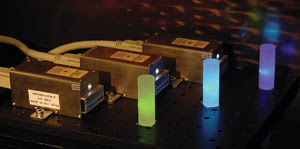This technology could be the answer to advancing optical data storage and laser-based projection displays for low-cost consumer applications.
Aram Mooradian, Bryan Moran and Rick Waltonsmith, Novalux Inc.
Vertical-extended-cavity surface-emitting lasers (VECSELs) will enable advancements in several important applications in 2004 and beyond. Laser-projection systems can take advantage of the technology to provide the “missing link” — a compact green source — that will lower system costs and promote wide acceptance in consumer applications. And in optical data storage, blue VECSELs are likely to be competitive with GaN devices.
A VECSEL is a unique semiconductor laser that emits a high-power circular beam from a large emitting area. It has demonstrated high reliability and reduced manufacturing costs because it is compatible with on-wafer test and burn-in for high assembly yields. The VECSEL manufacturing process is well-characterized and can be adapted to produce device parameters for different powers and wavelengths, and for pulsed or CW operation. It also is adaptable to various optomechanical packages.
VECSELs are well-suited for generating shorter wavelengths via second-harmonic generation because the nonlinear crystal can readily be placed inside the resonator for high conversion efficiency. Commercial units on the market offer outputs at 488, 460 and 532 nm. And, although they employ thermoelectric cooling to remove excess heat, next-generation VECSELs will be passively cooled and small enough to fit into a standard TO can.
A prime application for these lasers will be projection displays and optical data storage. Each of these applications has different wavelength, power and modulation requirements, and each will require a laser capable of being built in volumes exceeding 10,000 per week, at high yield and reliability.
Small RGB projection displays have a good source for the red wavelength, with the 635-nm laser diodes widely deployed in high-volume applications such as DVDs. GaN devices produce blue laser light in the 405- to 430-nm region and are moving toward the more desirable 460-nm, true-blue wavelength. But smallform-factor green lasers are not available, which is why a lot of interest is forming for a 532-nm VECSEL. Several multinational corporations are evaluating green VECSELs for projection displays.

Protera lasers use VECSEL technology at 532 nm (green), 460 nm (blue) and 488 nm (blue-green). At right is a 4-in. GaAs wafer.
Optical-data-storage manufacturers have targeted the 405-nm wavelength for the next generation of DVD players, and GaN lasers are just beginning to be deployed in this application. A 405-nm VECSEL is an alternative source but would have to prove itself in price and performance to secure design wins in this application. VECSELs emitting at 810 nm have been demonstrated, and commercial, frequency-doubled devices at 405 nm are expected to be available in 2004.
As projection-display technology matures, a high level of interest is developing around laser-based projection displays for conference rooms, HDTV and home entertainment screens. To enable true white-light images with a wide color gamut, medium-size displays will require RGB lasers to provide between 100 and 500 mW each. Laser selling prices in the $100 range per color will be needed to initiate this application in the marketplace. With conference room projectors now selling for less than $1000, laser-based displays will have to provide better projector size, light-source lifetime and electrical efficiency.
Two-dimensional VECSEL arrays may provide the solution for these larger, higher-power projection laser displays. The arrays would be frequency-doubled to produce green or blue output. VECSELs emitting in the red have yet to be demonstrated, but that is a challenge certain to be addressed by the manufacturers in the near future.
Meet the authors
Aram Mooradian is chief technical officer, Bryan Moran is an applications engineer and Rick Waltonsmith is director of sales and marketing at Novalux Inc. in Sunnyvale, Calif.